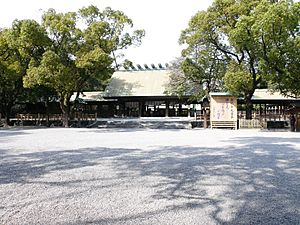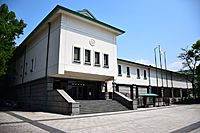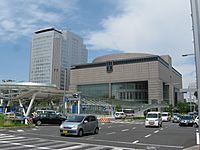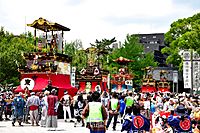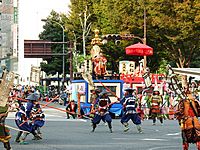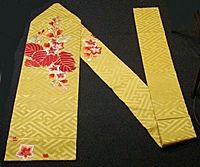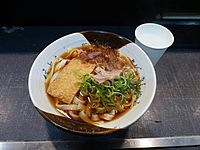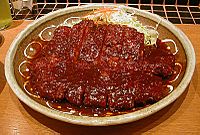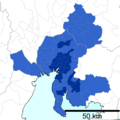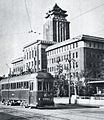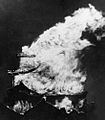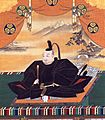Nagoya facts for kids
Nagoya is one of the largest cities in Japan, with over 2 and a quarter million people in 2010. It is in Aichi Prefecture. There are 16 wards in Nagoya.
Contents
Tourist attractions
- Nagoya castle: It was built in 1615 by Japan's famous military commander, Ieyasu Tokugawa. It is one of Japan's most famous castles. The gold dolphin-like fishes on the roof are its main feature. It is said that the total weight of the gold used is 215.3 kilograms.
- Nagoya City Science Museum: located in Shirakawa park in Naka-ku, Nagoya-shi. It reopened in 2011. Its planetarium is 35 meters in diameter. It is the largest in the world.
Culture
Nagoya was a major trading city and political seat of the Owari lords, the most important house of the Tokugawa clan. They encouraged trade and the arts under their patronage, especially Tokugawa Muneharu, the 7th lord, who took a keen interest in drama and plays and lived lavishly. Under his rule, actors and actresses began to visit Nagoya. Arts and culture was further supported by the city's wealthy merchants. Culture flourished after the feudal Edo period and the beginning of the Meiji era. During World War II many old buildings and artefacts were destroyed. The region's economic and financial power in the post-war years rekindled the artistic and cultural scene.
Museums
Nagoya has multiple museums, including traditional and modern art, handicrafts to industrial high-tech, natural and scientific museums.
Nagoya Castle's collection is from the Owari Tokugawa era. The main tower is a museum that details the history of the castle and the city. The Honmaru Palace, destroyed in World War II, is slated for reconstruction by 2016 and will again be a prime example of the Shoin-zukuri architecture of the feudal era. Tokugawa Art Museum is a private museum belonging to the Owari Tokugawa, who lived in Nagoya castle for 16 generations. Among other things, it contains 10 designated national Treasures of Japan, including some of the oldest scrolls of The Tale of Genji. The Nagoya Noh Theatre houses various precious objects of Noh theatre. The Nagoya City Museum showcases the history of the town.
Yōki-sō is a villa and gardens located in Chikusa-ku, close to Nittai-ji. It was constructed in the Taishō era for Ito Jirozaemon Suketami XV, the first president of Matsuzakaya.
Paintings and sculpture are exhibited at the Nagoya City Art Museum. Modern art is displayed at the Aichi Arts Center. The Aichi Arts Center also is the venue of rotating exhibitions. The city is also home to the Nagoya/Boston Museum of Fine Arts, a sister museum to the Museum of Fine Arts, Boston, which was founded to bring aspects of the MFA's collection to Japan.
The art of porcelain and ceramics can be seen at the Noritake Garden. Toyota has two museums in the city, the Toyota Automobile Museum which shows vintage cars, and the Toyota Commemorative Museum of Industry and Technology, which showcases company history, including its start as a textile mill.
The Nagoya City Tram & Subway Museum has trams and subway cars, as well as the Nagoya City Science Museum. The SCMaglev and Railway Park opened in March 2011 with various trains from the Central Japan Railway Company.
Other art museums in Aichi prefecture are the Aichi Prefectural Ceramic Museum and the Toyota Municipal Museum of Art. Meiji Mura is an open-air museum with salvaged buildings from the Meiji, Taishō and Showa eras. Another museum in Nagoya is the Mandolin Melodies Museum.
Other museums in the city include the International Design Centre Nagoya, the Japan Spinning Top Museum and the Bank of Tokyo-Mitsubishi UFJ Money Museum.
The civic authorities promote tourism and have taken steps to safeguard architectural heritage by earmarking them as cultural assets. Apart from the castle, temples, shrines and museums in the city, a "Cultural Path" was instituted in the 1980s, located between the Tokugawa Art Museum and Nagoya Castle. This residential area has historic buildings such as the Nagoya City Archives, the Nagoya City Hall main building, the Aichi Prefectural Office main building, the Futaba Museum, the former residence of Sasuke Toyoda, the former residence of Tetsujiro Haruta and the Chikaramachi Catholic Church. Most buildings date from the Meiji and Taishō era and are protected.
Theatres
Noh theatre and Kyōgen date back to the feudal times of the Owari Tokugawa. The Nagoya Noh Theater at Nagoya Castle continues that tradition and is a prominent feature in the cultural life of the city, with monthly performances.
Developed during the Edo period, one of Japan's kabuki grand stages is Misono-za, which also hosts various other Japanese entertainment such as concerts.
In 1912 the musician Gorō Morita invented the Nagoya harp music instrument.
In 1992, the large, modern Aichi Arts Center was opened in Sakae. It is the main venue for performing arts, featuring a main hall that can be used for opera and theatre and a concert hall. The Nagoya Philharmonic Orchestra performs there, as well as many visiting guest orchestras.
Festivals
Apart from the main national festivals and holidays, other festivals in Nagoya are unique to the city/region.
Major events include the June Atsuta Festival, the July Port Festival, the August Nagoya Castle Summer Festival Castle and the October Nagoya Festival. Wards and areas host local festivals such as the Daidō-chōnin Matsuri (大須大道町人祭, Street Performer's Festival) in Ōsu.
Dialect
The Nagoya dialect (名古屋弁, Nagoya-ben) is spoken in the western half of Aichi Prefecture, centering on Nagoya. It is also called Owari dialect (尾張弁, Owari-ben). The Nagoya dialect is relatively close to standard Japanese and to the Kansai dialect, differing in pronunciation and vocabulary.
Handicrafts
The industry of Japanese handicrafts in the city is centuries old.
- Arimatsu and Narumi dye: during the construction of Nagoya Castle in the 17th century, the lords of Owari called in skilled craftsmen from Bungo Province in Kyushu, known for their tie-dyed fabrics. These craftsmen and their families were treated generously by the Owari and settled in the Arimatsu und Narumi neighbourhoods. Only the base fabric is dyed, leaving parts that were knotted as white spots. This highly specialised process requires 6–12 months to complete.
- Geta clog straps: wooden clogs called geta were the shoes of the feudal era. The Owari devised a unique pattern for the cotton straps of the clogs and ordered them to be made by local weavers. The technique has developed over the generations. The straps became stronger and more resilient but more comfortable for the feet with the discovery of cotton velvet.
- Shippo: the technique for enamelware called shippo arrived from the Netherlands towards the end of the Edo period. The patterns appear almost transparent and are often used on pottery.
- Candles: wax is taken from a wax tree and painted around a rope made of grass and Japanese paper (washi) over and over again into layers. When cut in half, the candle looks as if it grew like a tree with rings. Japanese candles produce less smoke and are harder to blow out, since the wick tends to be larger. Artists paint the candles in coloured patterns.
- Yuzen: the art of silk dyeing was introduced by craftsmen from Kyoto during the rule of Owari Togukawa. The initial designs were extravagant and brightly coloured, but over time became more muted and light-coloured.
- Sekku Ningyo: festival dolls were introduced by markets during the Meiji era. Nagoya craftsmen rank among the top producers.
- The city also gave its name to a type of obi, the sash that is used to tie a kimono. The term Nagoya obi can refer to an older type of obi used centuries ago. This type was cord-like.
Cuisine
The city and the region are known for its unique local. Dishes include:
- Tebasaki: chicken wings marinated in a sweet sauce with sesame seeds, basically a type of yakitori
- Tenmusu: a rice ball wrapped with nori that is filled with deep-fried tempura shrimp
- Kishimen: flat udon noodles with a slippery texture, dipped in a light soy sauce soup and a sliced leek or other flavouring added. It can be eaten cold or hot.
- Red miso: various dishes that use red miso, such as miso katsu (pork cutlet with sweet miso sauce and miso nikomi udon (hard udon stewed in miso soup)
- Hitsumabushi: rice dish with unagi in a lidded wooden container. This dish is enjoyed three ways; as unadon, with spice and as chazuke.
In popular culture
Nagoya, especially Nagoya Castle, has been featured in three Godzilla movies: King Kong vs. Godzilla, Mothra vs. Godzilla, and Godzilla vs. Mothra. The city is also featured in Gamera vs. Gyaos and is the main setting of 2003 film Gozu. 1995 film The Hunted starred Christopher Lambert and the 1992 film Mr. Baseball starred Tom Selleck.
The city was the setting for the 2007 movie Ashita e no yuigon (translated as Best Wishes for Tomorrow), in which a Japanese war criminal sets out to take responsibility for the execution of U.S. airmen.
The anime The Wind Rises by Hayao Miyazaki, released in 2013, is a highly fictionalized biography of the Mitsubishi A6M Zero's chief engineer Jiro Horikoshi and takes mostly place in Nagoya of the 1920s and 1930s.
Related pages
Images for kids
-
Lexus LFA in Midland Square
-
Nagoya Castle and the Meieki district with skyscrapers (2018)
-
Nagoya Stock Exchange in the Isemachi district
-
Nagoya University campus in Higashiyama. The university has produced six Nobel Prize laureates in science.
-
Nanzan University main campus, designed by renowned architect Antonin Raymond in the 1960s.
-
Chubu Centrair International Airport, constructed on an artificial island
-
Central business district of Nagoya viewed from Midland Square (2015)
-
The Seigan-ji former family villa was the birthplace of Minamoto no Yoritomo, founder of the Kamakura Shogunate
-
Miya-juku (Atsuta Shrine) in the 1830s, as depicted by Hiroshige
-
Hirokoji in Nagoya during the Meiji era
-
Toyota Motor Corporation Koromo plant (now the Toyota Commemorative Museum of Industry and Technology) in 1938
-
The Expo 2005 was the second world's fair held in Japan
See also
 In Spanish: Nagoya para niños
In Spanish: Nagoya para niños


